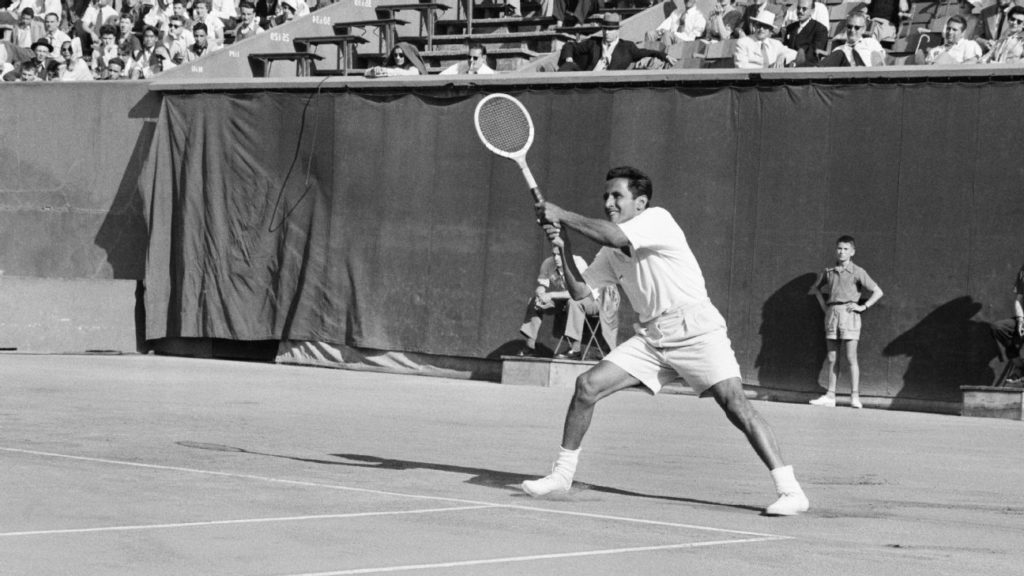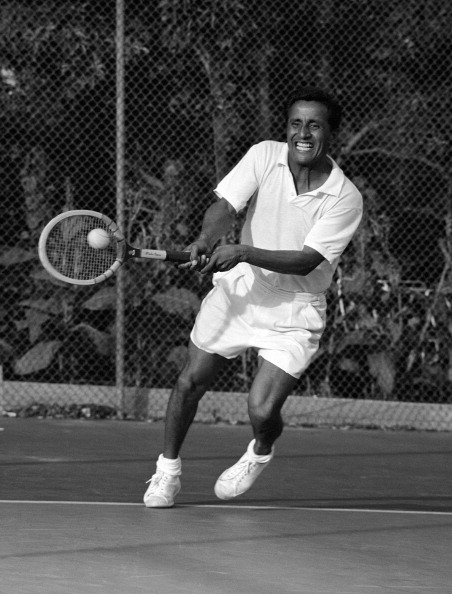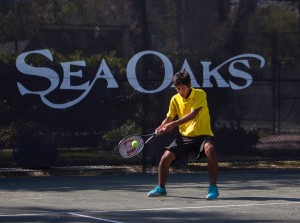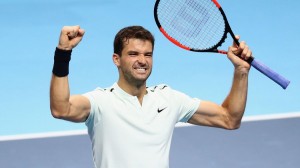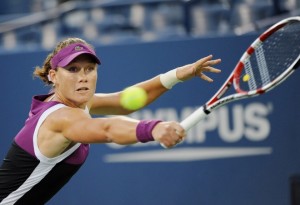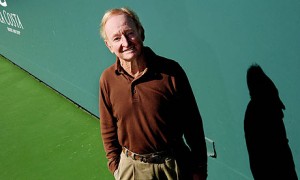Pancho Segura was one of the most charismatic and interesting people in the history of tennis. While he never won a Grand Slam tournament title, Segura’s success and longevity on the little-discussed pre-Open Era professional tour added to his legend. After his playing days, he was best known as the mentor and coach to Jimmy Connors.
The following is the biography of Segura, as it was written by the legendary Bud Collins in his encyclopedia of tennis “The Bud Collins History of Tennis.”
A curious sight was Francisco Olegario “Pancho” Segura when he appeared on the North American scene in 1941, a mite who began to make a big impression with jarring strokes and jovial personality despite seeming physical limitations. He had won his native Ecuadorian title at 17 in 1938 along with various other Latin American titles, and presently was on his way to big-time tennis in the U.S., riding a tennis scholarship at the University of Miami where his coach was Gardnar Mulloy, his Hall of Fame colleague-to-be. “Mulloy saved me. I didn’t have any money, and spoke no English, but he helped me with everything,” Segura recalls.
A big smile and a yen for the battle offset what appeared, at first appraisal, to be disadvantages: An unorthodox two-fisted forehand, flimsy-looking bowed legs and a 5-foot-8 frame. Yet his footwork was admirable. He was quick, nimble, extremely effective. By 1942, he had a No. 4 U.S. ranking, and would be the ever-welcome centerpiece at depleted home-front tournaments during World War II, his status as an alien keeping him out of uniform. Over the 1943-45 period, he was the big winner, grabbing 15 of 30 tournaments (7 of 10 in 1943) and 107 of 122 matches. He could never realize his dream of conquering the U.S. at Forest Hills, coming as close as the semis, 1942-45, and the quarters in 1946-47.
Segura was born June 20, 1921, in Guayaquil, Ecuador and was raised there. A childhood attack of rickets deformed his legs but his will was strong, and he drove himself to play tennis well, even though he was so weak at first that he had to grip the racket with both hands. A right-hander, he was likely the first to utilize a two-fisted forehand. At Miami, he won the National Intercollegiate singles in 1943-44-45, the only man since Malcolm Chace to take three straight—for Brown in 1893, and Yale in 1894-95. Pancho won the U.S. Indoor title of 1946 and the U.S. Clay Court of 1944 and was a member of the U.S. Top 10 six times, No. 3 in 1943-44-45.
But his best days were ahead of him, as a professional. After settling in the U.S., he left the amateurs in 1947, signing on to play mostly the secondary matches on the strung-out world-wide tour of one-nighters. Unfortunately for Segura, he was out of the limelight once he became a professional. While he lost to Aussie Dinny Pails, 41-31 at their end of his first tour (Jack Kramer and Pancho Gonzalez the headliners), he would overcome Frank Parker and Ken McGregor in their series. Sharpening his strokes and tactics and becoming one of the great players, he received little recognition. Kramer and Gonzalez were the stars, but Segura was making his mark in a small circle as a shrewd strategist, a cunning lobber and a killer with that (then) strange forehand.
And Pancho was becoming dangerous for anybody. He prizes a 6-4, 8-10, 1-6, 6-4, 6-3 victory over world-best Kramer in the semis of the U.S. Pro of 1950, a tourney he won over Frank Kovacs, forcing Kovacs to surrender with cramps. That earned Segura a tour against Kramer the following year, but Jack was still too strong, 64-28. Nevertheless, short Pancho was long on endurance. Again he won the U.S. Pro in 1951-52, both times over Gonzalez, seven years his junior—6-3, 6-4, 6-2; and 3-6, 6-4, 3-6, 6-4, 6-0. He then lost the finals to Gonzalez, 1955-56-57, as well as the final of the pros’ biggie, Wembley at London, to Gonzalez in 1951, 6-2, 6-2, 2-6, 6-4. There he made the final three more times, 1957, 1959-60, losing to 25-year-old Ken Rosewall in 1960. Segura was 39, and seven years later, he beat Rosewall during a tournament at Binghamton, N.Y. At 41, he lost his last U.S. Pro final, to Butch Buchholz, 6-4, 6-3, 6-4, in 1962. Pancho also won the U.S. Pro doubles with Kramer in 1948 and 1955, and Gonzalez in 1958.
He toured for more than two decades and stands as one of the prominent figures in the history of the pros’ days in the wilderness, prior to Open tennis. Hardy and good-natured, Segura was a favorite with crowds. He could always smile and crack a joke, yet was thoroughly professional and a constant competitor. He never made big money. Open tennis arrived too late for him, but he entered the doubles of the first open Wimbledon in 1968 with Alex Olmedo, and in the second round, they won the third longest doubles match of Wimbledon’s Open era, 94 games, over Abe Segal and Gordon Forbes, 32-30, 5-7, 6-4, 6-4. The 62-game set was the longest ever at Wimbledon.
When his playing career ended, he became one of the best teaching pros, settling in Southern California, and making his mark as one of the sharpest minds in the game. He was instrumental in Jimmy Connors’ development, and was elected to the Hall of Fame in 1984.
U.S. TITLES (14)—Intercollegiate singles, 1943, 1994, 1945; Indoor singles, 1946; Clay Court singles, 1944; Pro singles, 1950, 1951, 1952: Clay Court doubles, 1944, 1945 with Bill Talbert; Pro doubles, 1948, 1955 with Jack Kramer; 1954, 1958 with Pancho Gonzalez. SINGLES RECORD IN THE MAJORS—French (2-1), Wimbledon (2-2), U.S. (21-7).
